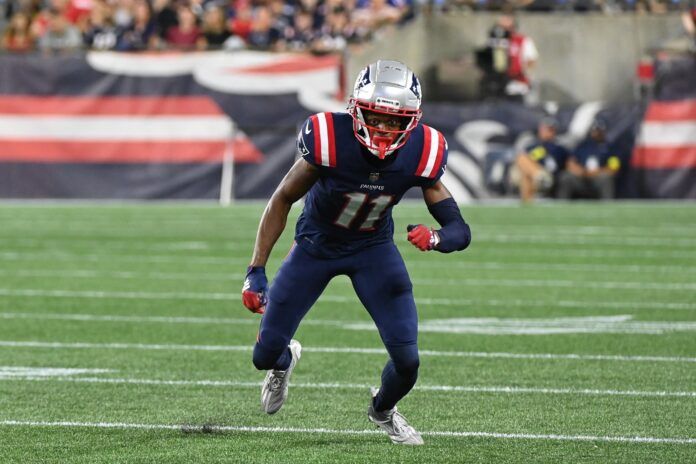DeVante Parker was traded to the New England Patriots this offseason, changing his fantasy football outlook for 2022 considerably. Let’s examine Parker’s ADP in 2022 fantasy drafts and whether he can return value on that investment for managers.
DeVante Parker ADP | Is he worth his current price in fantasy drafts?
Parker’s current ADP in redraft leagues is in the region of 150th overall in all formats. His ADP is marginally higher in non-PPR than it is in PPR leagues. In all three formats, Parker is being selected in the WR56-61 region on average.
In a 12-team league, the 150th selection is in the middle of the 13th round. That means that Parker is currently being drafted as a WR in one of the last bench spots on a roster. In deeper leagues, Parkers is a borderline 10th-round selection, where he will be a fringe starter.
Parker’s projected fantasy value in 2022
Parker’s career has been a constant frustration for fantasy managers. The first-round selection from the 2015 NFL draft managed to put it all together in 2019, where he finished sixth at the position in total fantasy points. On one hand, you can point to the fact that 2019 was the only year where Parker managed to suit up for all 16 games in a season since he was drafted.
However, it was not just about health. His 4.5 receptions per game in 2019 was matched in 2020, but Parker was averaging 75 yards per game and 0.56 touchdowns per game in 2019. In comparison, he could only average 56.6 yards per game and 0.29 touchdowns per game in 2020. He finished 2019 with 10.9 points per game in non-PPR and 15.4 in PPR. In 2020, those numbers dropped to 7.4 ppg in non-PPR and 11.9 in PPR.
A big part of that difference was Parker’s average depth of target (aDOT) in 2019 compared to the following two seasons. His aDOT was at 14.0 in 2019 before dropping to 9.7 and 11.5, despite playing under similar offensive schemes in all three years. A big difference is the QB he had throwing him the ball. In 2019, he had Ryan Fitzpatrick, who was willing to air the ball out, starting 13 games. Meanwhile, Tua Tagovailoa ran a slightly more conservative offense in 2020 and 2021.
Therefore, we have to ask whether Mac Jones and this Patriots offense are willing to air the ball out to increase Parker’s ceiling. Through his first two years, Tua averaged 7.24 intended air yards per pass attempt. In 2019, Fitzpatrick was sitting at 8.9. As a rookie, Jones averaged 8.0 intended air yards per attempt and had a receiver (Nelson Agholor) with a 14.2 aDOT last season.
If Parker can occupy Agholor’s role while also earning more targets than Agholor’s 4.27 per game, there is certainly the potential for him to reach his ceiling. The question is whether this Patriots offense can provide him enough targets to return value on his current ADP.
The Patriots’ offense and the depth chart are intriguing
There is some ambiguity over what sort of offense we will see from New England this season. Josh McDaniels has left to take a head coaching role in Las Vegas, and there is no defined offensive coordinator at this point. There is not even certainty over whether Bill Belichick, Matt Patricia, or Joe Judge will call plays.
However, there is the expectation that the offense will look to be very balanced. Last year, they had 535 passing attempted (25th in the league) compared to 489 rushing attempts (eighth). Accordingly, only Jakobi Meyers saw more than five targets per game. Hunter Henry, Kendrick Bourne, and Agholor all averaged between 4 and 4.5 targets per game.
This year, the depth chart has a lot of similarities around it. Damien Harris and Rhamondre Stevenson are back as the primary rushers. Henry and Jonnu Smith remain the top two tight ends. At wide receiver, Meyers, Bourne, and Agholor are all back, with Parker and rookie Tyquan Thornton as the main additions.
It appeared as though the main competition was between Parker, Agholor, and Thornton for Agholor’s starting role from last season. However, Thornton’s injury has left that as a straight fight between Parker and Agholor, which many believe Parker will win. However, Parker needs to earn more targets than Agholor to get close to matching his best returns.
Unfortunately, with a career catch rate of 57.8%, Parker is not a significantly “safer” target than Agholor proved to be last year. So expecting Parker to see a significant increase on the 4.27 targets per game that Agholor earned last year is optimistic.
Should you draft Parker in 2022?
For Agholor to return value on his current ADP, he does not need to get back to his very best fantasy returns. Even just reproducing his production from last year (6.4 ppg in non-PPR and 10.4 ppg in PPR) would present a value on his current ADP. The problem is that Parker produced those results while averaging 7.3 targets per game. We do not expect him to repeat those numbers this season in the Patriots’ offensive scheme.
While there might be an opportunity for slightly better efficiency, with Jones having been slightly more aggressive in terms of intended air yards than Tua last year, it will be hard to improve his efficiency enough to make up for a potential drop of three targets per game.
In our consensus 2022 WR fantasy rankings, Parker’s position is slightly below his current ADP across all three formats. He is a player that we are not actively targeting at his current ADP, but we would be willing to consider if he falls a round or two lower.
During his career, Parker’s usual returns have been in the WR40-55 region when things work well. We saw that there was a higher ceiling in 2019, but that was a perfect storm that he has never been close to repeating. There are players with a greater opportunity to earn an increased target share than Parker has in what should be a conservative Patriots offense.

